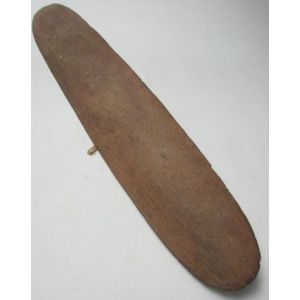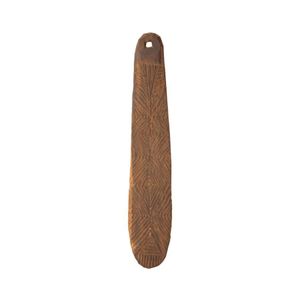Aboriginal Chevron Churinga
You must be a subscriber, and be logged in to view price and dealer details.
Subscribe Now to view actual auction price for this item
When you subscribe, you have the option of setting the currency in which to display prices to $Au, $US, $NZ or Stg.
- Patination / Patina - In broad terms, patination refers to the exterior surface appearance of the timber, the effect of fading caused by exposure to sunlight and air over the course of a century or more, changing the piece to a soft, mellow colour.
As patina is very difficult to replicate, it is one of the most important guides to determining the age of furniture.
Patina is also the term applied to the bloom or film found on old bronzes due to oxidisation. - Incised - A record of a name, date or inscription, or a decoration scratched into a surface, usually of a glass or ceramic item with a blunt instrument to make a coarse indentation. Compare with engraving where the surface is cut with a sharp instrument such as a metal needle or rotating tool to achieve a fine indentation.
- Chevron Motif - In jewellery, a chevron is a V-shaped pattern or design that is often used to create a bold and striking visual effect, and as a symbol of strength, power and protection.. It is a classic motif used in many different styles of jewellery and can be seen in various forms such as on a ring, earrings, bracelets, and necklaces. It can be created with precious or semi-precious stones, pearls, or enamel. It can be found in different forms such as engraved or inlaid or beaded.
In ceramics the pattern is often used in decorative pottery and porcelain pieces, such as vases, bowls, plates and figurines. The chevron pattern can be created by using different colored glazes or by hand-painting the design onto the piece. It is also commonly found in the form of embossing or intaglio in decorative ceramic objects. This pattern can be seen as a popular design choice in Art Deco and Art Nouveau style of ceramics.
This chevron pattern can also be found in many different types of furniture, such as tables, chairs, chests of drawers, and cabinets. A common place to find chevron pattern is in a herringbone pattern, which is made up of repeating V-shaped patterns. The chevron pattern can be created by using different types of wood, inlaying or by using different colors of stain. It is also commonly found in the form of a veneer. This pattern can be seen as a popular design choice in mid-century modern, Art Deco, and contemporary style furniture.
This item has been included into following indexes:
Visually similar items

A Lagrange shield. Length 70 cm

A Central Australian Aboriginal shield, hardwood with a series of incised designs to face, alternating between concentric circles and spirals, interspaced with lateral incised groves, length 75 cm

Wunda Shield, West Australian origin with incised decoration and remains of ochre, 75 cm

Papuan Gulf Club. Richly patinated palm wood club with openwork carving with red pigment and traces of lime. Length 111 cm. Width 8.5 cm. Provenance: T. Clemence Collection, New Zealand
